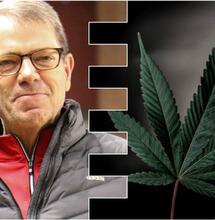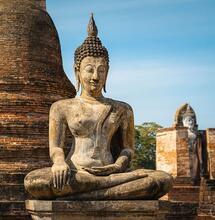Adventures in Moroccan Hash

Many people think they know a lot about Moroccan hashish, and I thought I did -- until I went there!
Many people think they know a lot about Moroccan hashish, and I thought I did -- until I went there!
|
The Ketama region provides breathtaking scenery, as well as excellent hash |
Having been a daily smoker of Cannabis for somewhere in the region of eighteen years, I had come to learn quite a lot about it, but it was not until I actually traveled to the Rif mountains that I received a real education in the subject.
History of Ketama Hash
Around seventy percent of the world's hash comes from Morocco, and about ninety-five percent of Morocco's hash comes from the province of Ketama - the province that dominates the Rif Mountains. The story goes that the people of Ketama always saw themselves as a separate entity from the state of Morocco; they resisted the Moroccan authorities for a long time, fought fiercely for their independence and were a constant 'thorn in the side' of the Moroccan state apparatus. One day, in the latter part of the mid-Twentieth century, the Moroccan monarch of the day offered them a deal - put your guns down, stop fighting us, submit to our rule and we will let you keep your hashish culture. This was agreed to and the people of Ketama tentatively agreed to join the young state we know as Morocco.
In the years following this agreement, the legalized Ketama hashish culture grew from strength to strength, until it dominated the agriculture of the region. However, the cultivation of Cannabis gradually began to seep outside the borders of Ketama. Export and tourist trades grew up around it and foreigners started to flock to this historically inhospitable region of North Africa.
These days, Ketama still has a fearsome reputation - a visit to the region is certainly not for the faint-of-heart, or those easily intimidated. There are a lot of big money dealers, smugglers, suppliers and farmers in the Rif. There are also a lot of crooked cops, soldiers, townsfolk and business owners there as well - pretty much everyone in the Rif seems to be involved in the hash business one way or another; it is the crop upon which the economy of the entire region is now based.
The above was, intentionally, a very brief and vague political history, because the real point of this blurb is to talk about the hashish itself.
|
Blonde hash is most typically prevalent across Morocco |
Types of Moroccan Hash
Using the title 'Moroccan hashish' is like using the title 'American movies'. A lot of American movies are made by a lot of different people; some are good, some are terrible; some are made by independent movie producers and distributed by independent distributors, while others are churned out by the giant movie houses and distributed by massive distribution companies. The same things can be said of Moroccan hashish.
In the Rif circa 2010 were growing three main strains of Cannabis: the traditional blonde Moroccan, a red Moroccan variety and a Pakistani variety. Certain growers were also stabilizing a new strain, a genetic combination of the three main strains - they call this 'Hardura'. It is important for these growers to continually crossbreed the strains and produce new seed stocks, in order to prevent the strains from stagnating and losing their vital characteristics.
How is Moroccan hash made?
Producing hash from these plants is quite a time-consuming business. First, the mature crop needs to be harvested; this is done around September or October, when the summer is drawing to a close. The plants are then completely dried, then put into storage until the weather gets cold. When the temperature drops, the hashish trichomes break away from the plant much more easily, boosting the quality of the final product.
Around November, the plants are traditionally put onto a fine mesh screen, which is secured over the top of a large bowl. The bowl and the plants are then put into plastic (fertilizer) bags and the top of the bag/screen is 'bashed' or repeatedly tapped, gently, with sticks - this knocks the trichomes from the plant so that they fall through the screen, into the bowl. The first bashing of each plant is known as Doble Zero Zero and is the best quality.
However, in order to make the very best quality hashish, one must be selective in the plants, and parts of plants, one chooses to bash. If you use the lower branches of a small, stunted plant, you are not going to get particularly good hash. This is because small plants are closer to the ground and far more prone to collecting the dirt and dust that gets blown around - do not forget, these are real plants grown in real dirt! A small amount of this natural 'pollution' is inevitable. If you choose the big top buds from a large, mature plant, then there should only be a minimal amount of dirt mixed in with the final product. The first bashing of the top buds of the biggest plants produces the best of the best!
The plants are retained after the first bashing, and put to one side. When the farmer or basher is satisfied with the amount of Doble Zero Zero they have accumulated, they will keep the hash in powdered form, wrap it in plastic and store it in a cool, dry place - this prevents the oils from evaporating too quickly. The plants are then bashed up to three or four times more, or until the farmer is happy with his collected weight of hashish - he might choose to keep the different grades separate, as each bashing produces a slightly lower quality than the previous one; he may also mix them all up into one batch. Regardless of how a farmer chooses to mix his hash, he always keeps it in powdered form until it is ready to be sold - all serious buyers and smokers will want to see their hash in this state before they part with their money.
|
Red Moroccan hash varieties tend to make smokers lose themselves in their own thoughts |
Blonde, red and Pakistani hash in Morocco
As stated earlier, there are three main strains grown in the Rif at the time of writing - blonde, red, and Pakistani. The blonde is the traditional hash of Morocco, and the hash most people tend to think of when they think of 'Moroccan' hash. The blonde variety has quite a smooth taste and a steady, heady high - she is not too strong, makes the smoker talkative and is a good high for getting things done. For every hundred kilos of plants, producers receive one kilo of good quality hashish. The red variety is a very different beast though, resulting in a strong, trippy high that hits you right between the eyes. She hits you fast, but wears off quite quickly as well. For every hundred kilos of the red plants, a kilo-and-a-half of good quality hash is produced.
The Pakistani is the queen of them all, though. She provides a strong, heavy effect that lasts a long time. If you are greedy and smoke a big joint of it in the morning, you can find yourself rooted for a good few hours until you finally manage to drag your dazed self to get something to eat. The best thing to do after that is find your spot again and roll another one, because she is a 'day killer'. Leave the Pakistani alone until the evening, if there are things that you want to accomplish that day. For the farmers though, the best thing about the Pakistani variety is that, for every hundred kilos of plants they bash, they receive two kilos of good quality hash.
I was not able to find out too many details about the Hardura strain - it is not being grown as extensively as the other three yet and is still not stabilized. I tried a few different batches and they varied in quality and strength.
Some farmers grow all of these varieties; some choose to grow only one or two. Some farmers have European contacts who supply them with different seeds, as well.
The best hash I managed to find out there was grown by a small-scale, independent farmer on the fringe of Ketama; his hash was a fifty-fifty Pakistani/Afghani combination. He had harvested it at the perfect time, at the end of a very good season; after the hash had been wrapped in plastic and walked on for a few hours inside his shoe, it was black on the outside but gray when it was torn open - the holy grail of quality hashish!
Why does the quality of Moroccan hash vary so much?
Quality is a big issue in the drug business; it is even difficult to find good quality hash in Morocco, once you are outside of the Rif region. A lot of the dealers use a range of pollutants to bulk-up the hash before they sell it on to Joe Smoker - this is one of the reasons the dealers like to buy it in its unpressed, powdered form.
Even before it is bulked-up by dishonest dealers, though, there are a number of other variables that affect the quality and quantity of the product. The amount of rainfall during the preceding winter will affect the size of the harvest; the amount of sun the crop receives while it is growing will affect the quality and quantity, as will the type and strength of the fertilizer used. A few days of gusty wind immediately before the harvest will affect the quality as well - if a lot of dust gets blown around the plants before they are harvested, a degree of natural contamination is unavoidable. If the plants are bashed in warmer-than-ideal temperatures, the plants have to be bashed harder than is preferable; this leads to a lower quality end product as well.
In spite of all this, added pollutants remain the most pressing problem. Unscrupulous dealers will use almost anything to bulk-up the hash - henna, coffee, sugar and dirt are the most common. Also, shit, plastic, shoe polish and anything else that looks even remotely like hash is used. This is why it is important to buy the powder, and to learn how to test it before you buy it.
|
Good quality hash should bubble when a flame is passed over it, and will ignite quickly |
How to test Moroccan hash for quality:
Testing hash is relatively simple, when you know how. The best method is to put a small amount of the powder into the palm of your hand and run the flame of a lighter over it a couple of times - good hash will bind together quite easily, if a little heat is shown to it. You can then press it, in your hand, and once you have got a solid piece, you should be able to run a flame over it and watch the oils bubble up. Good hash catches fire quite readily as well. The more heat you have to put through it before it binds together, the lower the quality is. (However, bear in mind that if you are trying to heat it up in the middle of winter, on the side of a damp and freezing mountain, it will take a bit longer than normal.) If you want to get really technical, you can take a 30-X microscope along with you and analyze the trichome heads in minute detail, but the flame test is always the best and you may end swapping your scope for a bit of smoke, anyway!
If you are lucky enough to be presented with a variety of strains and qualities, you will be free to concoct your very own mixture. Maybe you want twenty grams of fifty-percent Blonde '00' and fifty-percent Pakistani '00'? Maybe twenty kilos of seventy-percent Pakistani #2, ten-percent Blonde #2, ten-percent Red #2 and ten-percent henna? The possible combinations are endless, and the price will vary accordingly.
|
Getting high, Rif-style |
In summary, the variety of seed, freshness of seed stock, amount of rain, soil quality, length of the summer, time of harvesting, amount and type of fertilizer, the wind, temperature at the time of bashing, number of bashings the plants have had - and the levels of natural and added pollutants - will all affect the quality of the hash. Moroccan hash varies from year to year, valley to valley, from farmer to farmer, batch to batch, and even from day to day. However, once you get your head around a few of these variables, you will be better informed than the vast majority of smokers on the planet.
Post script: After seven months of research in Morocco, I was finally able to give up my compulsive and damaging, eighteen-year daily habit. Having learned more about the business than I ever imagined there was to know and having spent those months immersed in the home of hashish means that, when I have the choice between smoking some second- or third-rate Cannabis or smoking nothing at all, I would rather smoke nothing at all. There is still nothing quite like getting high on some good pot, but why waste time, money, lung capacity and gray matter getting fucked up on some over-fertilized, badly grown, adulterated and uncured weed?



